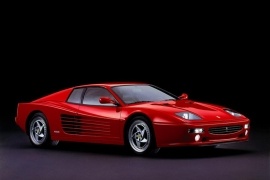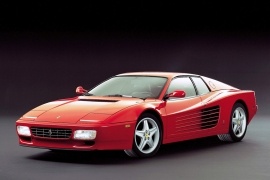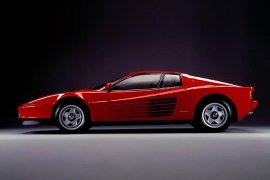FERRARI Testarossa/512 TR/512M Models/Series Timeline, Specifications & Photos
First production year: 1984
Engines: Gasoline
Body style: Coupé (two-door)
It was the final round for the much-acclaimed Ferrari Testarossa, a car that entered automotive history and pop-culture.
Back in the days, Ferrari used to put the Testarossa (red-head) name to the vehicles that featured twin-cam engines. Later on, due to the widespread of that distribution technology, the name became obsolete. In 1994 it was still considered a hot feature for a car. Moreover, the Testarossa was also praised in international music hits such as the one from Sir Mix-A-Lot.
Ferrar 512 TR/M featured the same shape as its predecessor, but with a few styling changes. At the front, one of the most noticeable difference was the framed headlight, which replaced the pop-up ones. The stylists installed an oval-shaped grille on the front bumper. The 512 M didn't have that many changes from its sides, apart from the smaller Pininfarina badges. It was the back that was enhanced, with an open view to the four-round taillights. Previously, those were hidden behind the rear grille.
Inside, the Italians didn't work too much. They just took a trip to their local tuning shop and brought an aluminum knob for the gear stick and drilled aluminum pedals. To cover their lack of action, Ferrari decided to put the AC on the standard options and change the 512 TR with a 512 M badge on the glove compartment.
Under the hood, the 1994 model featured an improved version of the flat-twelve engine. It offered the same 4.9-liter displacement but gained around 12 horses over its predecessor. Due to titanium connecting rods and a new crankshaft, the engine was lighter than the one fitted inside the 512 TR.
The Ferrari Testarossa was a legendary supercar that inspired the pop-culture of the '90s, and the evolution that followed, the 512 TR, was even better.
In the '90s, it was hard o beat Ferrari at its own game. There was only one true contender for it: the Lamborghini Diablo, but that couldn't match its beauty. Its lines were easy to recognize, and its flat-12 sound was hard to forget.
Pininfarina designed the car with pop-up headlights and big stationary lamps on the front bumpers. The front grille was smaller than the one fitted in the Testarossa and sported rounded corners instead of just its predecessor's squared design. Its long side slats guided the air to the mid-mounted engine were kept since they became a specific design element. In the rear, the taillights were hidden under a black grille with horizontal bars.
Ferrari designed the car as a sport-touring car, even though it could beat most of the other vehicles on the road. It offered comfortable sport-bucket seats with leather upholstery and the magical chromed metallic grate for the gear stick with a dog-leg pattern.
There was the magical flat-twelve engine upgraded behind the cabin that produced 430 hp from a 4.9-liter displacement. It featured a Bosch injection system, and the factory offered a sports exhaust system that made the car roar even better. Its track abilities were not too affected by the softer dampers needed for a relaxed drive in a touring car. Its 41/59 weight distribution allowed the vehicle to be driven hard on the race track.
The Ferrari Testarossa was one of the most iconic models built by the Italian carmaker, a legendary car due to its complex design and strange engine.
Ferrari used the name Testarossa (red-head) for vehicles with two overhead camshafts. Over time, that technical detail became so common that it didn't worth mentioning it over time. In 1984, when the car was introduced, it was still a great achievement. For that engine, Pininfarina built a special bodywork.
The Testarossa was instantly recognizable due to its side air-intakes for the engine. The long slats that were continued on the door panels channeled the air into the radiators to cool the engine. But more than their functional value, their look was even more important and gave the car a specific stance. At the front, the pop-up headlights and the black grille at the lower part of the bumper were specific car signatures. At the back, Pininfarina installed the taillights behind a black grille with horizontal slats. Unlike many other Ferraris, the Testarossa's taillights were big and squared.
Inside, the designer used leather for most of the panels. The designer wrapped the door panels, the dashboard, the sun visors, and the headliner with leather apart from the bucket seats. The gear-stick popped out from the floor, without a proper center console to surround it. A small storage compartment found its way between the occupants.
The monster, boxer-12 engine was based on the 1975 Formula 1 unit. Its architecture allowed the car to have a very low gravity center to increase the cornering speed. It was paired to a standard 5-speed manual gearbox.


